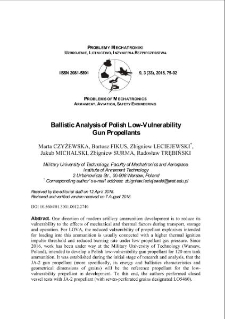Nasza Biblioteka Cyfrowa udostępnia 1 868 obiektów cyfrowych
Obiekt
Tytuł: Ballistic Analysis of Polish Low-Vulnerability Gun Propellants ; Ballistic Analysis of Polish Low-Vulnerability Gun Propellants
Tytuł odmienny:
Analiza balistyczna polskich małowrażliwych kompozycji prochowych ; Analiza balistyczna polskich małowrażliwych kompozycji prochowych
Współtwórca:
Bartosz FIKUS, Zbigniew LECIEJEWSKI, Jakub MICHALSKI, Zbigniew SURMA, Radosław TRĘBIŃSKI ; Bartosz FIKUS, Zbigniew LECIEJEWSKI, Jakub MICHALSKI, Zbigniew SURMA, Radosław TRĘBIŃSKI
Abstrakt:
One direction of modern artillery ammunition development is to reduce its vulnerability to the effects of mechanical and thermal factors during transport, storage and operation. For LOVA, the reduced vulnerability of propellant explosives intended for loading into this ammunition is usually connected with a higher thermal ignition impulse threshold and reduced burning rate under low propellant gas pressure. Since 2016, work has been under way at the Military University of Technology (Warsaw, Poland), intended to develop a Polish low-vulnerability gun propellant for 120 mm tank ammunition. It was established during the initial stage of research and analysis, that the JA-2 gun propellant (more specifically, its energy and ballistics characteristics and geometrical dimensions of grains) will be the reference propellant for the low-vulnerability propellant in development. To this end, the authors performed closed vessel tests with JA-2 propellant (with seven-perforated grains designated LO5460). This paper contains comparative (with the JA-2 propellant) results of closed vessel tests of several propellant blends developed by the MUT Faculty of New Technologies and Chemistry research team. Closed vessel tests of these propellant blends were performed in the Ballistics Laboratory of the MUT Institute of Armament Technology using a manometric chamber with a volume W0 = 200 cm3. Experimental tests and theoretical analyses were performed based on provisions of the standardisation agreement STANAG 4115 [6], American military standard MIL-STD 286C [7] and original test procedures developed based on [8, 9]. The tests focused mainly on the issue of correlation between the chemical composition of the given propellant blend with the expected values of energy and ballistics characteristics in connection with the required shape of propellant grains.
;
One direction of modern artillery ammunition development is to reduce its vulnerability to the effects of mechanical and thermal factors during transport, storage and operation. For LOVA, the reduced vulnerability of propellant explosives intended for loading into this ammunition is usually connected with a higher thermal ignition impulse threshold and reduced burning rate under low propellant gas pressure. Since 2016, work has been under way at the Military University of Technology (Warsaw, Poland), intended to develop a Polish low-vulnerability gun propellant for 120 mm tank ammunition. It was established during the initial stage of research and analysis, that the JA-2 gun propellant (more specifically, its energy and ballistics characteristics and geometrical dimensions of grains) will be the reference propellant for the low-vulnerability propellant in development. To this end, the authors performed closed vessel tests with JA-2 propellant (with seven-perforated grains designated LO5460). This paper contains comparative (with the JA-2 propellant) results of closed vessel tests of several propellant blends developed by the MUT Faculty of New Technologies and Chemistry research team. Closed vessel tests of these propellant blends were performed in the Ballistics Laboratory of the MUT Institute of Armament Technology using a manometric chamber with a volume W0 = 200 cm3. Experimental tests and theoretical analyses were performed based on provisions of the standardisation agreement STANAG 4115 [6], American military standard MIL-STD 286C [7] and original test procedures developed based on [8, 9]. The tests focused mainly on the issue of correlation between the chemical composition of the given propellant blend with the expected values of energy and ballistics characteristics in connection with the required shape of propellant grains.
Miejsce wydania:
Warszawa
;
Warszawa
Wydawca:
Wojskowa Akademia Techniczna ; Wojskowa Akademia Techniczna
Data utworzenia:
Data złożenia:
Data wydania:
Rozmiar:
Identyfikator:
oai:ribes-88.man.poznan.pl:2518
Sygnatura:
DOI 10.5604/01.3001.0012.2740 ; DOI 10.5604/01.3001.0012.2740
ISSN elektroniczny:
ISSN drukowany:
Język:
Właściciel praw:
Wojskowa Akademia Techniczna ; Wojskowa Akademia Techniczna
Strona początkowa:
Strona końcowa:
Tom:
Słowa kluczowe:
mechanics, internal ballistics, closed vessel tests, low-vulnerability propellant ; mechanics, internal ballistics, closed vessel tests, low-vulnerability propellant
Kolekcje, do których przypisany jest obiekt:
Data ostatniej modyfikacji:
18 wrz 2025
Data dodania obiektu:
18 wrz 2025
Liczba wyświetleń treści obiektu:
0
Wszystkie dostępne wersje tego obiektu:
https://ribes-88.man.poznan.pl/publication/2826
Wyświetl opis w formacie RDF:
Wyświetl opis w formacie OAI-PMH:
| Nazwa wydania | Data |
|---|---|
| Ballistic Analysis of Polish Low-Vulnerability Gun Propellants | 18 wrz 2025 |
Obiekty Podobne
Marta CZYŻEWSKA Radosław TRĘBIŃSKI
Marta CZYżEWSKA Radosław TRĘBIŃSKI
Marta CZYżEWSKA Radosław TRĘBIŃSKI
Marta CZYżEWSKA Jakub MICHALSKI, Zbigniew SURMA
Marta CZYżEWSKA Radosław TRĘBIŃSKI

